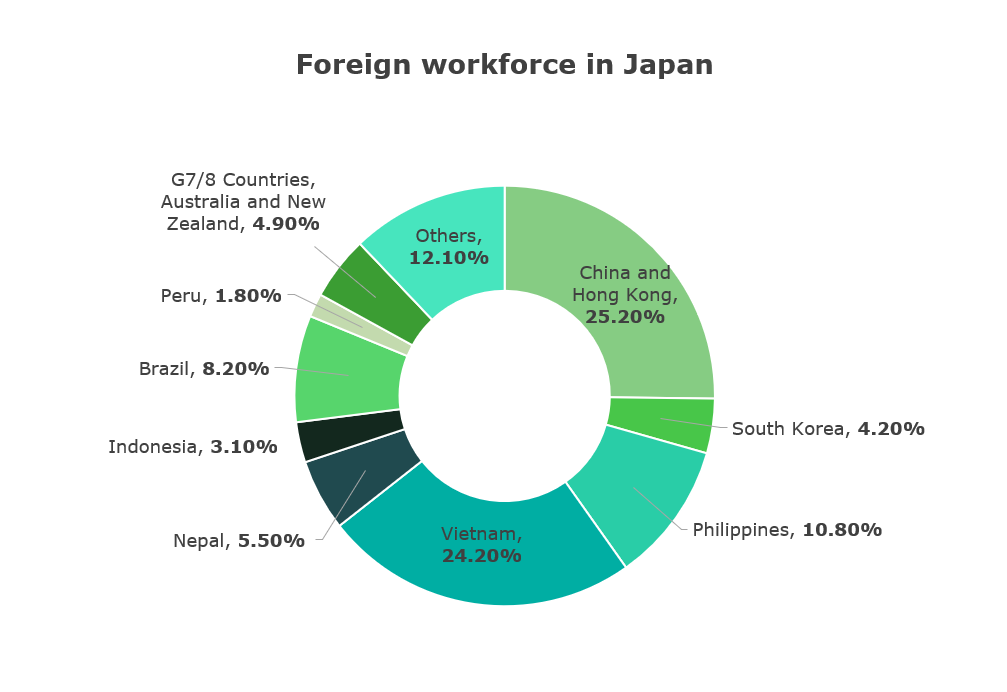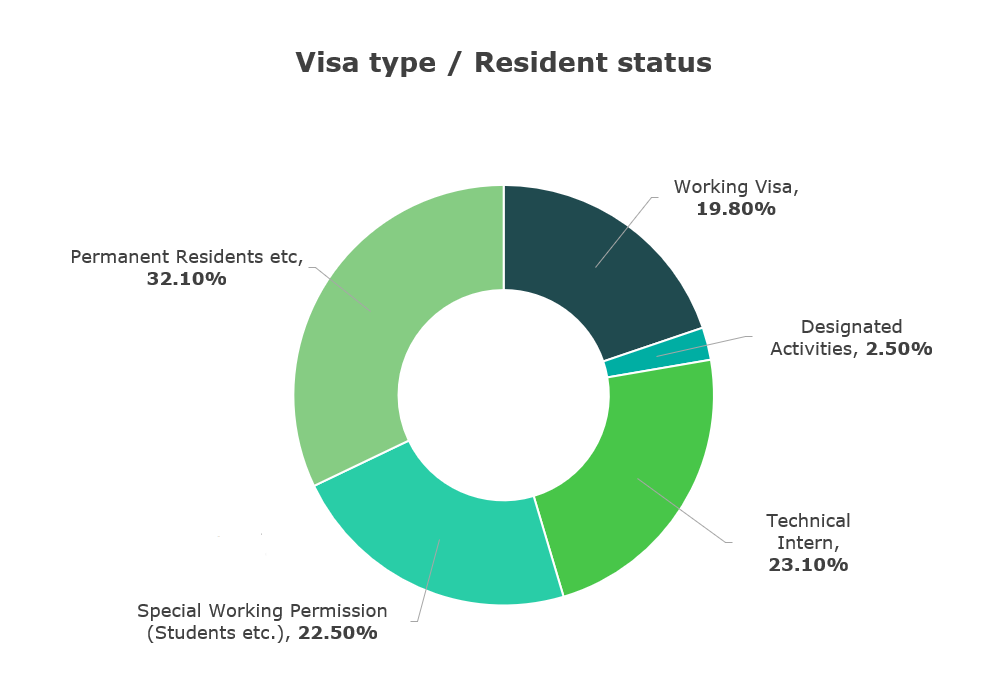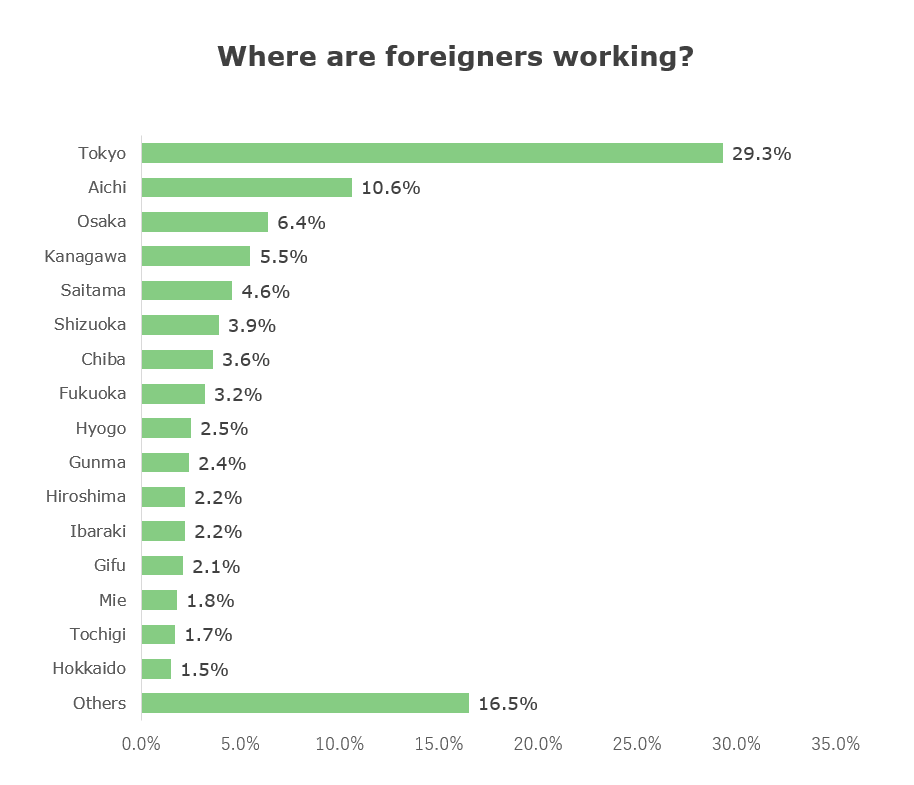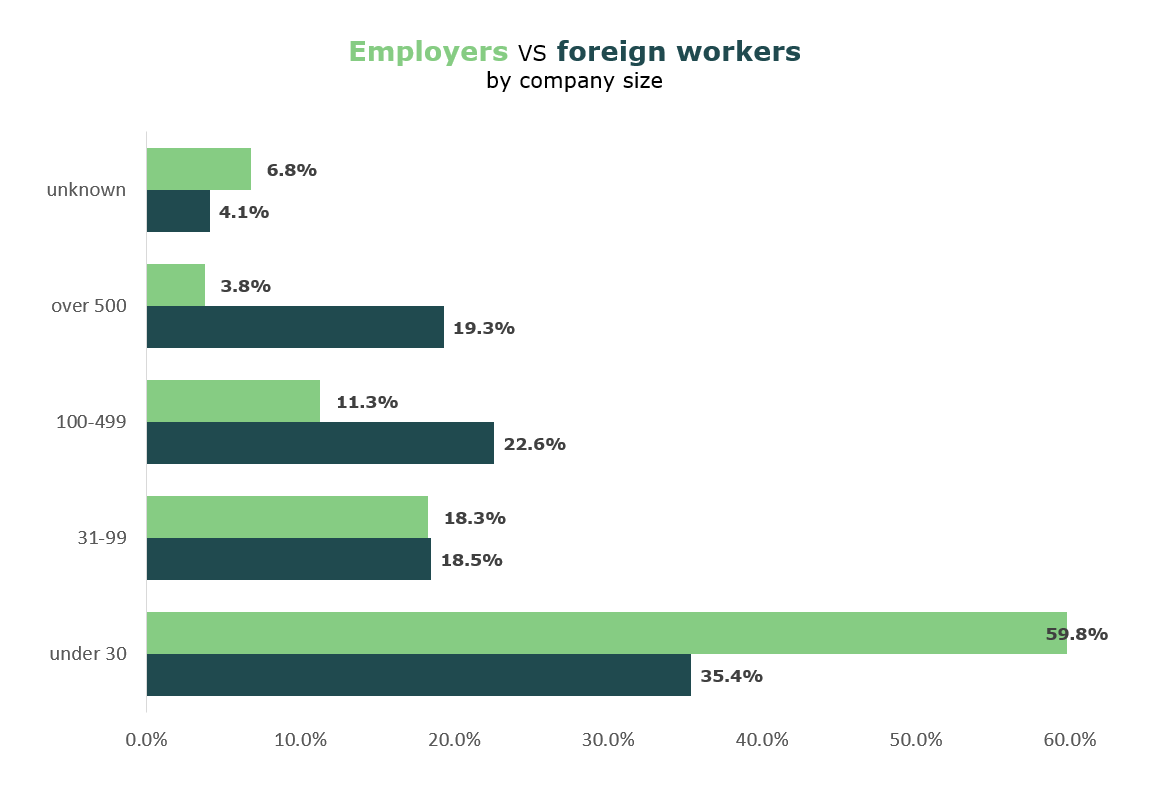On the Rise: Foreign Workers in Japan

by Madelaine
Have you ever wondered how foreigners who are working in Japan got here and what they are doing now? Did you know that only around 20% of all the foreigners living in Japan are here on a working visa? Let’s find out more about the foreign workers in Japan by looking at recent data published by the Japanese Ministry of Health, Labor, and Welfare in 2019!
コンテンツ
How many foreigners are working in Japan?
As of October 2019, there were 1.658.804 foreigners working in Japan. This equals 1.3% of the Japanese population or 12% of the population of Tokyo. Not bad for a country that has a history of closing itself off and newcomers face significant language and cultural hurdles. This influx of foreigners is a steady trend. In 2019, the total went up by 13.6% percent compared to the 1,460,463 foreign employees in 2018.
Reasons for this increase are two-fold.
First, more foreigners are entering the Japanese job market. Especially, foreigners working in highly skilled positions and the number of exchange students are on the rise. Also, more permanent residents than ever are taking up work.
Secondly, the Japanese government states that this trend is facilitated by an improvement of the general employment situation.
In December 2019, 2.933.137 foreigners were residing in Japan in total. That means that only around 45% of all foreign residents are actually working. The other 55% are staying here as students (and not working), as permanent residents (as a housewife or stay-at-home dad), as retirees, etc. But for now, let’s take a closer look at those foreigners with jobs in Japan.
Where are they from?
418.327 Chinese employees make up the biggest group of the foreign workforce at around 25%. They are followed by Vietnamese, whose numbers have skyrocketed in recent years, and Filipinos. The groups with the most growth – compared to 2018 – were people from Vietnam (+26.7%), Indonesia (+23.4%), and Nepal (+12.5%).
In total, more than 60% of the foreigners working (more specifically, around 73%) in Japan come from East and South-East Asia.
Brazil, once the goal for many Japanese emigrants, now also features prominently with around 135.500 Brazilians currently living in Japan. Other South American and African nationals are too small in numbers to feature in the data on their own and are summarized under “others”.
The data provided by the ministry groups most western countries together in one category called “G7/8 plus Australia and New Zealand.” This category includes the United States, Canada, France, Germany, Italy, the United Kingdom, and Russia (plus Australia and New Zealand, of course). Even when counting everyone from these countries, they still only add up to 5% of all foreigners residing in Japan. Among these western nationals, North Americans are by far the most numerous.
What about their age?
Most foreigners who are coming to live in Japan are in their 20s. It makes sense if you consider that whether as students, interns or on a working holiday visa, a broad variety of options are available for the younger generations. These programs and visas are made available to foster exchange of people and knowledge. Nevertheless, they are intended to be a limited time experience for participants. So many leave again after their stay is over.
Even those who find work here and stay long-term may eventually leave for personal reasons. Two years (urban legend) is supposedly the turning point for most. If you stay longer, chances are you have found a new home here in Japan.
What visa type?
Nationality and age are nice to know, but how do they manage to live in Japan? Looking at the visa status there are 3 main routes foreigners can take to work in Japan.
Permanent resident
One in three working foreigners is living in Japan under the status of 身分に基づく在留資格 which means they are permanent residents, or someone’s wife or child. Roguhly one third of all foreigners in Japan are living here under this status.
Student part-timers and technical interns
The second largest groups are 技能実習 (Technical Intern) and 資格外活動 (Special Working Permission).
The Special Working Permission category includes all people who do not have a regular working visa but can work under certain conditions. If you wonder who that might be – most of them are international students! These student part-time workers make up a sizeable chunk of the foreign workforce in Japan.
The Technical Intern group is about the same size. These interns working full-time for training purposes and who are employed at Japanese companies for a maximum of 2 years.
Working adult
Are you thinking about working full-time in Japan, without being married (or otherwise related) to a Japanese national? Then you fall into the “working visa” category, which makes up around 20% of all foreigners living Japan. As a company employee, you will be joining the ranks of these 329.034 individuals.
Where are foreigners working?
Foreign workers are where the work is. With Tokyo offering the most available jobs in the country, that’s where you will find them. Close to 30% of foreigners are working here. The number rises to around 45% if you include surrounding prefectures like Saitama, Kanagawa, and Chiba.
With some distance, other hot spots are Aichi prefecture (Nagoya), home to 10.6% of all foreign workers, and Osaka with 6.4%. Aside from these major population centers, other “local hubs” are Fukuoka, Hiroshima, and Gifu. In all other prefectures, foreign workers are still somewhat rare.
In which industries are foreigners working?
In total, 242.608 companies hire foreigners in Japan. The number of companies employing foreigners is increasing every year.
Top top 5 industries with the most foreign workers are:
- Manufacturing (29.1%)
- Service Industry (16.1%)
- Wholesale/Retail (12.8%)
- Hotels and Restaurants (12.5%)
- Construction (5.6%)
There is also a constant need for skilled people in Education and in Telecommunications. For instance proficiency in English is in demand to staff the many English language schools in Japan. Since no professional background is required, the work as English teacher is a popular choice, especially for North Americans and Europeans.
In Manufacturing, Service, and Education the number of employees in percent outranks the percentage of hiring companies in this industry. This means that these industries often hire multiple foreigners. On the other hand, in Construction, Wholesale and “Others,” many of the companies hire rather few, sometimes only 1-2 foreigners.
While the demand has been increasing steadily, most jobs in Manufacturing, the Service Industry, and Construction are not available for people here on a working visa. Jobs that are considered to be “unskilled labor” can only be done by foreigners working part-time or those living here on a family visa, permanent residents and those with new type of “skilled worker” visa.
Similar to the case of “westerners” being aggregated into one category earlier, 17.3% of all foreign employees are summarized in the category “other”. Here you will find all the “salarymen” and “OL (office ladies)” and most other jobs outside of service, wholesale, and production. In short, for most planning to get a regular working visa, this data is not detailed enough.
Small company? Big company?
59.8% of places that hire foreigners are small companies with less than 30 employees. With increasing company size, you will find less and less places looking to hire. While it is true that many foreigners find work in smaller companies, this data does not mean that you will have a hard time finding a job at a big company, if that is what you want.
Remember that the big companies simply can offer that much more positions. Companies with more than 500 employees make up only 3.8% of places that are hiring, but they employ 19.3% of the foreign workforce.
On the opposite side, one in three foreigners chooses to work for small companies with less than 30 employees.
Growing opportunities
This was a lot of data. It is clear, that Japan is increasing opportunities for foreigners to find work in the country. Many people wanting to live in Japan are making use of these developments.
Japan’s overall population is still shrinking and accepting more foreign workers into the country is key to dealing with the ramifications of this trend. In 2019, a new status of residence/visa called “Specified Skilled Worker” (特定技能) was introduced to alleviate serious labor shortages in sectors such as construction, hospitality, fishery, and food production.
READ ON Specified Skilled Worker Visa
Other industries like IT or Education didn’t get a new visa, but are looking for and hiring more and more foreigners as well.
I hope that by looking at what foreigners in Japan are doing, you will get a better idea of what your options are and how to make the most of your stay.
To recap:
- ■ More and more foreigners are working in Japan.
- ■ Despite the rising numbers of foreigners, full-time employment is still comparatively uncommon.
- ■ The best chances to come and experience Japan are in your 20s as student or intern.
- ■ You are most likely to find a job are in Tokyo, but it is also the most competitive region.
- ■ Remember to research in advance which jobs are available to you with your skills and Japanese language ability.
What do you want to do in Japan? How do you think the employment situation for foreigners in Japan will change in the future?
Share your thoughts in the comments!
Recommended Posts

How to Get Along with Your Japanese Boss
25 5月 2021 - Work, Working Culture

The 10 Most Popular Japanese Companies in 2021
19 5月 2021 - Work







